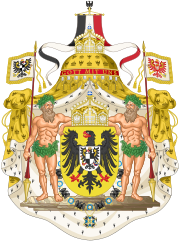Prince Waldemar of Prussia (1817–1849)
| Prince Waldemar of Prussia | |||||
|---|---|---|---|---|---|
 | |||||
| Born | 2 August 1817 Berlin, Prussia | ||||
| Died | 17 February 1849 (aged 31) Münster, Prussia | ||||
| |||||
| House | Hohenzollern | ||||
| Father | Prince Wilhelm of Prussia | ||||
| Mother | Landgravine Marie Anna of Hesse-Homburg | ||||
| Prussian Royalty |
| House of Hohenzollern |
|---|
 |
| Descendants of Frederick William II |
|
Prince Waldemar of Prussia (Friedrich Wilhelm Waldemar von Preußen) (Berlin, 2 August 1817 – Münster, 17 February 1849) was a son of Prince Wilhelm of Prussia and Landgravine Marie Anna of Hesse-Homburg. He was a Major general in the Prussian Army and a traveller.
Biography
[edit]Waldemar was born in Berlin, the son of Prince William, the youngest brother of King Frederick William III. Of his 4 brothers, only Prince Adalbert survived his childhood. His youngest sister Marie was Queen of Bavaria.
As a young man, Waldemar entered the Prussian army and raised through the ranks to become a Colonel in 1844.
His urge to see distant lands led him to the Mediterranean, to South America and in 1844 to India, where he traveled to the Himalayas via Calcutta and Hindustan. His journey came to an end with the First Anglo-Sikh War. He witnessed the first day of the Battle of Ferozeshah (21/22 December 1845), but when his companion, childhood friend and German physician and botanist Werner Hoffmeister was fatally hit by a bullet, British commander Hugh Gough urged Prince Waldemar to return home.
Back in Germany he became commander of the 13th Cavalry Brigade in Münster on 9 March 1848. But weakened by the hardships of the journey and the Indian climate, he died there on 17 February 1849.
Prince Waldemar maintained a travelogue during his journeys composed of his diaries, sketches of Egypt, Iraq, India, Calcutta, Delhi, Lahore, Bombay, Nepal, and other locations. Zur Erinnerung an die Reise des Prinzen Waldemar von Preußen nach Indien 1844-1846, translated In Memory of the Journey of Prince Waldemar of Prussia to India in the Years 1844-1846,[1] was printed posthumously in two volumes. Prince Waldemar’s diary depicts sacred places, people, and painted lithographs of the sketches. Pastoral Landscapes of the Middle Eastern, Indian, and South Asian countryside, such as the Sri Dalada Maligawa, Temple of the Tooth.


Published works of the expedition included writings and sketches of Werner Hoffmeister and others as well, additional record of the journey can be found in Briefe aus Indien. Von Dr. W. Hoffmeister, Arzt im Gefolge Sr. Königl, Hoheit des Prinzen Waldemar von Preußen [2]
Honours
[edit]He received the following orders and decorations:[3]
 Kingdom of Prussia:
Kingdom of Prussia:
- Knight of the Black Eagle, 2 August 1827;[4] with Collar, 1835
- Pour le Mérite (military), 18 December 1846[5]
 Kingdom of Hanover: Grand Cross of the Royal Guelphic Order, 1843[6]
Kingdom of Hanover: Grand Cross of the Royal Guelphic Order, 1843[6] Electorate of Hesse: Grand Cross of the Golden Lion
Electorate of Hesse: Grand Cross of the Golden Lion Hohenzollern: Cross of Honour of the Princely House Order of Hohenzollern, 1st Class
Hohenzollern: Cross of Honour of the Princely House Order of Hohenzollern, 1st Class Russian Empire: Knight of St. Andrew
Russian Empire: Knight of St. Andrew United Kingdom: Honorary Grand Cross of the Bath (military), 10 November 1846[7]
United Kingdom: Honorary Grand Cross of the Bath (military), 10 November 1846[7]
Ancestry
[edit]References
[edit]- ^ Prince Waldemar (1853). Zur Erinnerung an die Reise des Prinzen Waldemar von Preußen nach Indien 1844-1846, In Memory of the Journey of Prince Waldemar of Prussia to India in the Years 1844-1846. Berlin.
{{cite book}}: CS1 maint: location missing publisher (link) - ^ Von Dr. W. Hoffmeister, Arzt im Gefolge Sr. Königl, Hoheit des Prinzen Waldemar von Preußen (1847) Briefe aus Indien. Archive.org
- ^ Preußen (1848). Handbuch über den Königlich Preußischen Hof und Staat: für das Jahr .... 1848. Decker. p. 6.
- ^ Liste der Ritter des Königlich Preußischen Hohen Ordens vom Schwarzen Adler (1851), "Von Seiner Majestät dem Könige Friedrich Wilhelm III. ernannte Ritter" p. 19
- ^ Lehmann, Gustaf (1913). Die Ritter des Ordens pour le mérite 1812–1913 [The Knights of the Order of the Pour le Mérite] (in German). Vol. 2. Berlin: Ernst Siegfried Mittler & Sohn. p. 414.
- ^ Hof- und Staats-Handbuch für das Königreich Hannover. Berenberg. 1847. p. 61.
- ^ Shaw, Wm. A. (1906) The Knights of England, I, London, p. 190
